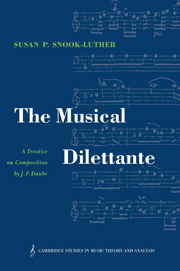Book contents
- Frontmatter
- Contents
- Foreword
- Translator's preface
- Introduction
- THE MUSICAL DILETTANTE: A TREATISE ON COMPOSITION (1773)
- Preface
- 1 Harmony in general
- 2 The three different motions of the voices
- 3 Combining two voices
- 4 Combining three voices
- 5 Combining four voices
- 6 Composition in five and more parts
- 7 Variation
- 8 Imitation
- 9 Canon
- 10 Simple fugue
- 11 Double counterpoint
- 12 Double fugue
- Bibliography
- Index
Translator's preface
Published online by Cambridge University Press: 15 October 2009
- Frontmatter
- Contents
- Foreword
- Translator's preface
- Introduction
- THE MUSICAL DILETTANTE: A TREATISE ON COMPOSITION (1773)
- Preface
- 1 Harmony in general
- 2 The three different motions of the voices
- 3 Combining two voices
- 4 Combining three voices
- 5 Combining four voices
- 6 Composition in five and more parts
- 7 Variation
- 8 Imitation
- 9 Canon
- 10 Simple fugue
- 11 Double counterpoint
- 12 Double fugue
- Bibliography
- Index
Summary
In translating J. F. Daube's The Musical Dilettante: A Treatise on Composition (1773), my aim has been to provide an accurate rendering of the author's ideas, while preserving the clarity and fluency of his prose.
Daube occasionally describes procedures and styles without using technical labels, since many of the concepts presented antedate standardized terminology, i.e., quartet styles and fugal writing. This practice is reflected in the translation, although modern terms sometimes appear in square brackets and/or in footnotes for the sake of brevity and clarification. In the same vein, and partly to preserve the original connotative value, descriptive German terms are often expressed literally, rather than by a more common foreign equivalent, i.e., “der herrschende Akkord” as “the ruling chord” rather than “the tonic chord,” and “der Endigungston” as “the ending tone” rather than “the final, finalis, or tonic note.” (Also, Daube's use of “die Note” always carries a rhythmic connotation, and is therefore translated as “note”, to distinguish it from the more commonly used “Ton, ” which usually refers primarily to pitch.)
For insight into eighteenth-century shades of meaning of German words and musical terms, I have consulted Sulzer's Allgemeine Theorie (1771, 1774), Koch's Lexicon (1802), and Adelung's Wörterbuch (1796), among others. In cases in which the meaning of an entire clause or section was ambiguous, I based my interpretation upon accompanying examples, or passages dealing with similar concepts in Daube's other theoretical works.
- Type
- Chapter
- Information
- The Musical DilettanteA Treatise on Composition by J. F. Daube, pp. xi - xivPublisher: Cambridge University PressPrint publication year: 1992



